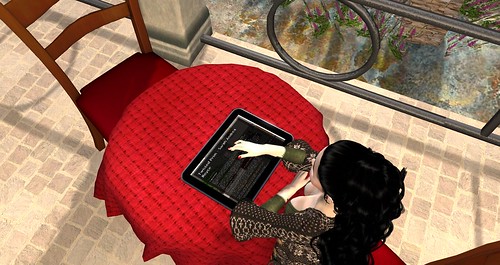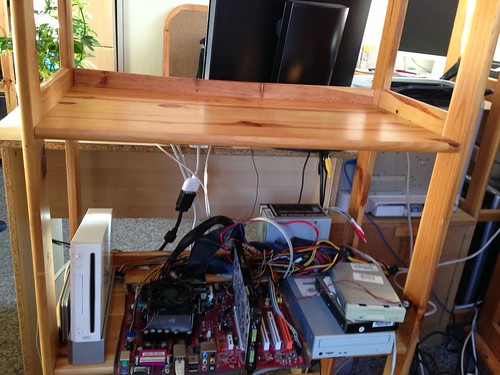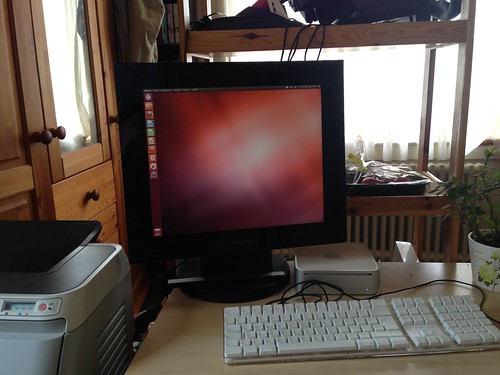You remember the summer of '13? Ok, Ok, it's still summer technically but this year was unusually cold. Which is, I read, actually a good thing as the wide spread of mobile computing reduced the demand of paper, thus for the first time in at least a century giving the worldwide forests a much needed regrow pause, but also affects the already disturbed climate and thus lead to a very cold year. But suddenly there were a few days in between where the temperature jumped about 15° to 20° (Celsius / Kelvin) and this was, when I learned, that it was a bad idea, when I had a cooler failure last year, to quickly buy a cheap cooler to replace it. The new and cheap cooler couldn't handle the higher temperature, and I used the Mini Mac at the time because the main computer always froze. This lead to many things I wrote about in the last post, like putting the off time to good use and building the Ubuntu PC.
When the heat wave was over, I felt secure again, even doing some stress tests, one of which is entering Second Life. It worked, but I still experienced occasional freezing, and I started to watch the core temperatures. It couldn't be worse, given the least bit of load the temperatures idled around 100°C only a tick more and the system made an emergency stop and froze. So I decided to invest on a new cooler. And this time a really good one please. I broke my headset, too and needed replacement, so I paid my local dealer a visit and nearly my last money.

I decided to take the Skythe Mugen 3.
It had some of the best tests and the architecture made it easy to clean, a feature that couldn't hurt. Yet I had to nearly completely disassemble it to have full access to the mainboard from all sides to install the cooler. So I did it. Now I could see, why I got cooling problems after the heatwave:

Astonishing enough, the CPU was unharmed.
And killed my mainboard. This is actually a first, I never managed to kill a mainboard, even the one that is now in the open computer survived its unassembled state and several moves. Maybe that made me a tad bit too careless. However, that meant I had to order a new board which would take several days to arrive. Pretty handy that I now had two systems at hand that I could use alternatively, even if I couldn't do a lot of things, like development with GameMaker or Visual Studio or simply gaming. Well, I could access Second Life on the Ubuntu system that had my old GeForce 9800 GT in it, and actually the Second Life client worked about as well on my AMD 3800+ at 2Ghz with 2GB as it did on my 2.83Ghz Core2 Quad system with 4GB before I started upgrading that. I was honestly impressed. And the 'feeling' of the Ubuntu desktop was great, responsive, intuitive unlike anything that I had experienced with Linux after about 15 years using various Linux computers as workhorse. I did wet my toes and tried desktop variants, but that never really worked out, even early Ubuntu variants. Now its on a stage I would give an Ubuntu system to a non nerd. And what may be the greatest surprise, it was even better than the Max OS X Lion on the Mac Mini (which is a Core 2 Duo at 2 Ghz with 4GB, but only onboard graphics). I added the 560 GTX OC and a Full HD display from the defunct main system, but at least Second Life wise, it didn't make that much of a difference, there is a point when adding better GPUs doesn't do much more and the 9800 GT seems to be a good fit for that system. Actually, all in all it was so good, that in all those days I had to wait for the mainboard, I didn't switch once to work with the Mac Mini, despite that one having all the commercial software, like Adobe Products and Microsoft Office. But I prefered the use of Open Source software for a long time now, and am used to Libre Office and the Gimp, which run perfectly fine on all three system (which really is a plus for each of them) and used the time to train myself more on Blender, anyway.
Another thing I recognized was that the combination of a 5:4 1280x1024 display on the left with a Full HD display worked better than two Full HD displays. The 5:4 format is ideal for books or websites, wheras I use the right full hd display for the real work. When the "information screen" is to big combined with my workstyle of having a lot of programs open at the same time it gets too crowded, wide (thus away from my main field of view) and distracting.
So after using each system for a while, I can make my final verdict:
Usability
- 1. Windows 7
- 2. Ubuntu
- 3. Windows 8 (Microsoft gets worse instead of better :-( )
- 4. Mac Os X
Software availability
- 1. Windows (any version)
- 2. Max Os X
- 3. Linux
What I can and will do, is installing an Ubuntu on my main system as a second bootable os. I'm very curious how that will turn out.

It's alive again... and pretty crowded.
Back at my main System. Despite the fact that nearly no part of my main system is still what I once bought as a complete system 5 years ago, with one of the noteable exceptions being the CPU, and it being at least twice as fast now, (a lot more even when it comes to the GPU) and I had no problems with games thus far I begin to feel how its outdated. Well cooled it now runs better than ever, yet e.g. when it runs the Second Life client, its framerate drops significantly sometimes, depending on what visible and how much CPU pre processing is needed. Not stable enough to make Machinimas, a hobby that I actually experimented with and liked, but ultimatly stopped because I couldn get stable 24FPS (espacially with FRAPS running, too).
I plan on purchasing an i5 3770k and a fitting mainboard and ram, and to overclock it, in about two to three months, as my budget has to recover first... or should I go for the Oculus Rift first? Second Life will support it at the end of the 'official' Summer.

When I said I'd like an Oculus Rift for Second Life I didn't mean it this way ;-)









